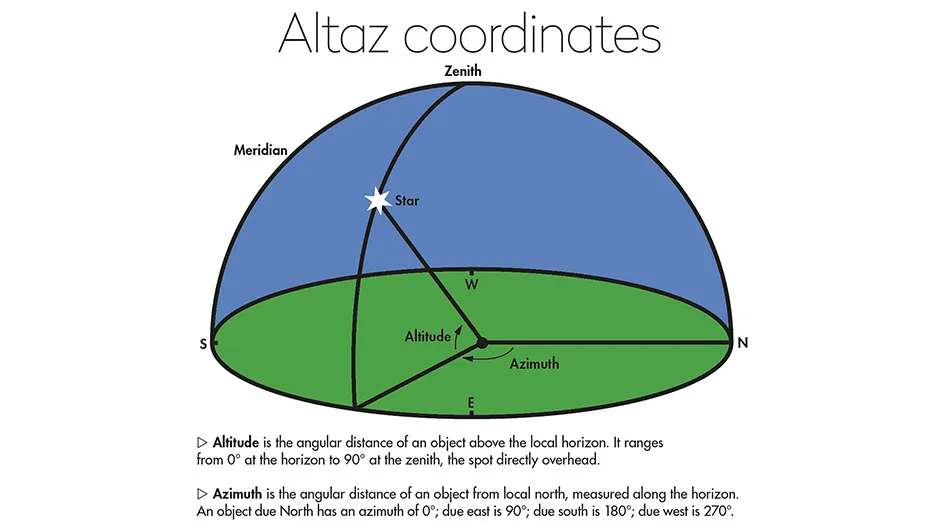So, what coordinates would you like to use to locate your star?Altaz? RA and Dec.? Ecliptic? Galactic?
Is the Universe trying to confuse us?Why are there so many?
The coordinates we use to locate places on Earth – longitude and latitude – seem simple enough.
You can pinpoint anywhere by knowing how many degrees, minutes and seconds somewhere is north or south of the equator, and east or west of the Prime Meridian.
Why not adapt this system for the sky and leave it at that?
Put simply, it’s because the sky appears to be constantly on the move as the Earth both spins and orbits around the Sun.
And unlike Earth’s surface, the sky has many possible frames of reference to use depending on what you want to achieve or, indeed, where you might be viewing from.
Assuming you’re viewing from Earth – as most of us will be (for now) – there are two main systems astronomers use which differ quite significantly, but which both have their particular practical uses.
Altaz – which is short for altitude and azimuth – is, like longitude and latitude, measured in degrees, minutes and seconds.
It describes an object’s place in the sky at any given moment in relation to the horizon: degrees along it (azimuth) and degrees up from it (altitude).
Degrees of difference
This system is specific to your location on Earth.
So, for example, if someone in Edinburgh sees a star at 46° high in the southern sky, someone in London will see that same star at 51° instead.
This is because London is just over 5° further south than Edinburgh on Earth’s surface.
Also, because Earth is rotating this means the altaz coordinates are constantly changing as the stars move across the sky.
This is why planetarium software shows the altaz coordinates changing in real time when you click on any target in the sky.
This is a problem addressed by the Equatorial system, a way of pinpointing a star that is standardised wherever on Earth you happen to be.
Put simply, it takes the imaginary grid of latitude and longitude lines from Earth’s surface and projects them onto the sky, to create what is known as the celestial sphere.
It ignores the fact that stars are different distances from us and thinks of them all as if they were painted on the inner surface of a vast, hollow globe with a tiny Earth at its centre.
So Earth’s equator is extended outwards to become the celestial equator, while Earth’s poles become celestial north (roughly Polaris, which can be found using our guide on how to find the North Star) and celestial south.
Lines of latitude become lines of declination (Dec., measured in degrees, arcminutes and arcseconds), which indicate how far north (a positive value from 0° to 90°) or south (a negative value from 0° to -90°) of the celestial equator the object lies.
Lines of longitude become right ascension (RA), measured in hours, minutes and seconds east from where the celestial equator intersects the ecliptic (or the plane of Earth’s orbit) for the vernal equinox.
Why the sudden change to hours? It’s a logical extension of timing the passage of objects as Earth rotates, with the sky literally divided into 24 hours.
So in one hour of time a star will move (roughly) across 15° of sky (360° ÷ 24 hours).
So what you end up with is equatorial coodinates that looks something like this one for the star Alnitak in Orion’s belt: 05h 40m 45.52666s, −01° 56’ 34.2649”.
There is a little glitch in the system, owing to the fact that a wobble in the Earth’s axis means that equatorial coordinates drift through 360° over a period of 25,772 years.
So, for example, the north celestial pole today lies near Polaris but 5,000 years ago it lay close to Thuban in Draco.
This gradual change means that equatorial star maps need to be reset periodically: mid-last century they were set to use the stars’ positions as seen from Earth in 1950 as the reference point, whereas current charts use 2000.
So, if the equatorial system works so well, why do we still need altaz?
That’s down to telescope mounts.
Altaz mounts are generally cheaper and quicker to set up, but equatorial mounts are a must-have for astrophotography, which relies on tracking objects.
Neither is ‘better’ than the other.
It’s horses for courses.
And they’re both a little more accurate than, “Second star to the right, and straight on till morning.”

Even more coordinates
Along with the standard two coordinate systems there are several others that you may come across that are not usually useful for amateur astronomy.
Ecliptic longitude/latitude
There are two variations, geocentric and heliocentric.
Geocentric uses Earth’s orbital plane as a reference and was used in ancient times to work out the positions of the planets in the sky.
Heliocentric uses the Sun at its centre and is used for accurately working out the positions of the planets and their orbital elements.
Galactic longitude/latitude
Beyond our Solar System the normal coordinate system breaks down completely so the plane of our Galaxy is used for the reference plane instead but with the Solar System still at the centre and the Galactic centre used as a fixed point of reference.
The Supergalactic system
This system uses the distribution of several of the largest galactic supercluster groups as its plane of reference.
International Celestial Reference System
This is almost the same as the equatorial system but uses the centre of our Solar System instead of Earth for reference.
Astronomy writer and broadcaster Paul Money is reviews editor for BBC Sky at Night Magazine

